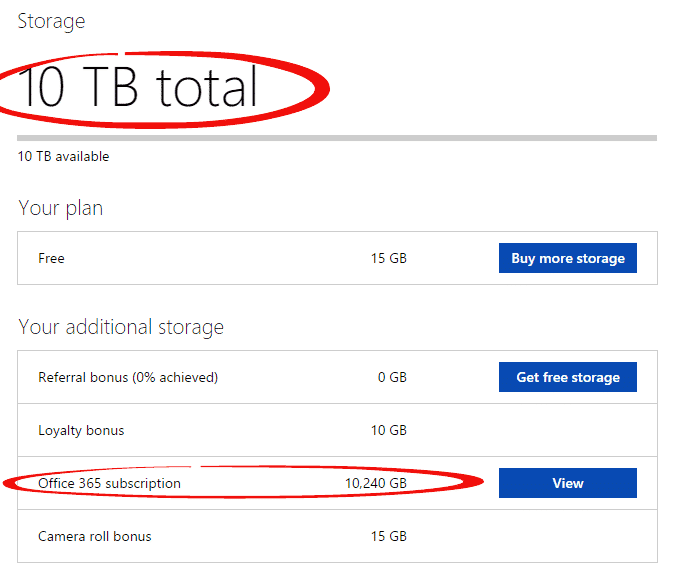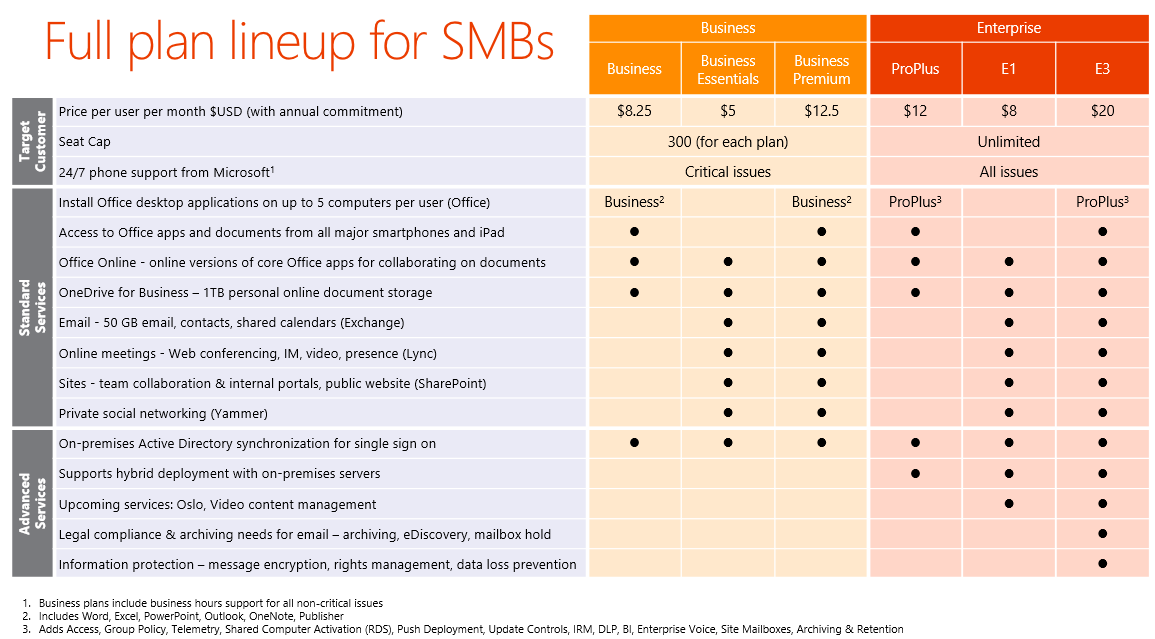A little over a year ago, Microsoft announced that paid Office 365 Home and Personal subscribers would get, as part of their subscription, unlimited cloud storage on its OneDrive service. Yesterday, the company announced that it wasn't going to do that after all. It turns out that if you offer unlimited storage to people, a few of them actually take you at your word and trust that you are truly offering unlimited storage, and then they start using it.
- Onedrive Unlimited Space
- Onedrive Unlimited Photo Storage
- Onedrive Unlimited Storage
- Onedrive Unlimited Storage Free
- Onedrive Unlimited Space
How to Use Microsoft OneDrive for Virtually Unlimited Photo Storage? OneDrive is an extensive online service offered by Microsoft. It allows you to backup and share photos, videos and files on a server and access them from anywhere on any device or using a browser with an internet connection. You just need to use a free Windows Live ID to login. .Unlimited individual cloud storage for qualifying plans for subscriptions of five or more users, otherwise 1 TB/user. Microsoft will initially provide 1 TB/user of OneDrive for Business storage, which admins can increase to 5 TB/user. .Unlimited individual cloud storage for qualifying plans for subscriptions of five or more users, otherwise 1 TB/user. Microsoft will initially provide 1 TB/user of OneDrive for Business storage, which admins can increase to 5 TB/user.
Explaining the backtracking, the new blog post complains that a small number of paying customers were using OneDrive to store backups of multiple PCs and large collections of movies and TV shows. Some of these outliers used more than 75TB of space, which Microsoft says is 14,000 times the average (putting the average OneDrive user at about 5.5GB).
Instead, paid users will now receive only 1TB of storage, a reversion to the service's previous limit. The company is also removing its old 100GB and 200GB paid plans, replacing them with a 50GB plan at $1.99 a month. Free OneDrive storage is also being cut early next year, from 15GB to 5GB, and there's no more 15GB bonus for storing your camera roll in OneDrive. Going forward, OneDrive users with more than 1TB of data will have a one year grace period during which they can keep their large storage, after which they must cut back to below 1TB. Similarly, free users with more than 5GB of data will have a year after the change is made to reduce their usage to below the 5GB level.
AdvertisementPaying users not happy at the reduction in storage will be offered pro-rated refunds.
Although this was announced yesterday, we have had occasional reports over the last few months from paying Office 365 subscribers telling us that their OneDrive accounts were capped at 1TB. According to these users, customer service reps were telling them there was no unlimited storage and that 1TB was the limit. As such, it looks as if this change may have been in effect for some time prior to the decision to go public.
This change is frankly rather alarming. That people were using its unlimited storage service for unlimited storage has apparently caught Microsoft off guard. Even though this is a problem that virtually every 'unlimited' product suffers—for example, the Verizon FiOS 'unlimited' customer using 77TB of bandwidth a month or every mobile operator throttling its heaviest 'unlimited' users—it appears that Microsoft did not take occasional heavy users into account when making its offer, and so it has decided to kill it off.
This comes as Microsoft has made it easier than ever to use lots of OneDrive storage; Groove Music knows how to play music stored on OneDrive, so it's worth uploading all your songs to Microsoft's cloud so that you can play them from anywhere.
Cloud backup provider Backblaze, whom we've written about a number of times over the years, offers unlimited backup storage for $5 per month. The company tells us that it does so profitably. Yes, occasionally some users use many more times the average. 75TB users certainly aren't going to be profitable for Microsoft; even before redundancy and replication is taken into account, that's around $1,800 of raw disk capacity, and a subscriber paying $70 a year isn't going to come anywhere close to covering that cost. But if Backblaze's accountants and engineers can provide cost-effective storage on an unlimited basis that can accommodate rare extremely heavy users, it makes one wonder why Microsoft cannot—and why the company apparently didn't check the viability of offering unlimited storage before the offer was made, rather than after.
AdvertisementThis isn't the only way that Microsoft has made OneDrive less attractive over the last few months, either. In Windows 8.1, the integrated OneDrive client was really quite clever, using local 'placeholder' files to represent data that was available in the cloud but not yet downloaded locally. Opening these files from Explorer or most applications would cause the download to occur automatically, enabling the cloud storage to act as a kind of seamless extension of local storage.
The system wasn't perfect, with some issues around making the behavior clear and some compatibility limitations. These problems were not insurmountable, but instead of fixing them, Microsoft simply ditched the entire concept in Windows 10. The Windows 10 OneDrive client reverts to the same kind of syncing behavior as is used by, for example, Dropbox, requiring much more manual management of what gets synced and what doesn't.
The company has made vague promises to produce an updated OneDrive client that improves the sync experience, but as things stand right now, using OneDrive in Windows 10 is markedly worse than using it in Windows 8.1. Dropping the unlimited storage similarly makes it worse. And killing off the camera roll extension means that one of the most widely applicable paths into using OneDrive for one's cloud storage needs is gone. Does Microsoft even want us to use OneDrive anymore?
If it were any other service, we'd almost feel suspicious that the poor management and reduction in capabilities were precursors to winding the entire thing up. OneDrive is too important to Windows and Office 365 for that to be in the cards, but it nonetheless makes us wonder why this core service appears to be getting worse and why the company is willing to undermine the trust people had in the service by changing the terms of its service in a way that has no benefits, only downsides. This doesn't just reflect badly on OneDrive. It reflects badly on Microsoft's entire position as a provider of cloud services: it calls into question Microsoft's ability to deliver what it said it would deliver.
-->OneDrive for work and school accounts is online storage space in the cloud that's provided for individual licensed users in an organization. Use it to help protect work files and access them across multiple devices. OneDrive lets you share files and collaborate on documents, and sync files to your computer. Learn more about OneDrive features, functionality, and pricing.
OneDrive is included in Microsoft 365 and Office 365 plans, in SharePoint plans, and can also be purchased as a standalone plan.

For detailed plan information on subscriptions that enable users for OneDrive, see the full subscription comparison table and Compare OneDrive for Business plans.

Note
OneDrive standalone plans include Office for the web.
System requirements
To review the requirements for the OneDrive sync app and mobile app, see OneDrive system requirements.
Storage space per user
2 GB
- Office 365 Enterprise F3
- Microsoft 365 F1
- Microsoft 365 F3
Onedrive Unlimited Space
1 TB
- Microsoft 365 Business Basic
- Microsoft 365 Apps for business
- Microsoft 365 Business Standard
- Microsoft 365 Apps for enterprise
- Office 365 Enterprise E1
- Office 365 Government G1
- Microsoft 365 Business Basic for nonprofits
- Microsoft 365 Business Standard for nonprofits
- Office 365 E1 for nonprofits
- OneDrive for Business Plan 1
- SharePoint Online Plan 1
- Microsoft 365 Business Premium
Beyond 1 TB, to unlimited
1 TB per user for subscriptions with fewer than 5 users. For subscriptions with 5 or more users (can be any combination of qualifying plans), Microsoft will initially provide 1 TB per user, which admins can increase to up to 5 TB per user. (To learn how, see Set the default storage space for OneDrive users.) To request additional storage, admins must contact Microsoft Support.
- Office 365 Enterprise E3
- Office 365 Enterprise E5
- Office 365 A1
- Office 365 A3
- Office 365 A5
- Office 365 US Government G3
- Office 365 US Government G5
- Office 365 E3 for nonprofits
- Office 365 E5 for nonprofits
- OneDrive for Business Plan 2
- SharePoint Online Plan 2
- Microsoft 365 Enterprise E3
- Microsoft 365 Enterprise E5
- Microsoft 365 A3
- Microsoft 365 A5
- Microsoft 365 US Government G3
- Microsoft 365 US Government G5
- Microsoft 365 E3 for nonprofits
- Microsoft 365 E5 for nonprofits
Onedrive Unlimited Photo Storage
Note

You must assign at least one license to a user before you can increase the default OneDrive storage space.
When you need cloud storage for individual users beyond the initial 5 TB, admins can open a case with Microsoft technical support to request it. Additional cloud storage will be granted as follows:
When a user has filled their 5 TB of OneDrive storage to at least 90% capacity, Microsoft will increase your default storage space in OneDrive to up to 25 TB per user (admins may set a lower per user limit if they want to).
For any user that reaches at least 90% capacity of their 25 TB of OneDrive storage, additional cloud storage will be provided as 25 TB SharePoint team sites to individual users. Contact Microsoft technical support for information and assistance.
To see the storage space and usage for an individual user, go to Manage storage in the OneDrive sync app. To see how much storage users across the organization are using, go to the OneDrive usage report in the Microsoft 365 admin center.
Supported uses
OneDrive storage is provisioned on a per user basis and is designed to serve the needs of individual users.
Storage of data other than an individual user's work files, including system back-ups and departmental and organizational level data, is not supported, nor is the assignment of a per user license to a bot, department, or other non-human entity. SharePoint is the best solution for more advanced content management and collaboration, including storing and managing files, communications, and intranet sites across a team or organization.

OneDrive limits
To learn about file and sync limits, see SharePoint limits and Invalid file names and file types.
For plans that include unlimited cloud storage for individual users, note that limits may apply on non-storage features.
Sync features
Anyone whose plan includes OneDrive can use the OneDrive sync app unless their IT department explicitly disables it. To install the latest sync app, go to the OneDrive download page.
Unless otherwise noted, the following features are available across all plans that include OneDrive, and all OneDrive standalone plans:
- Files On-Demand for Windows 10 and for Mac
- Known Folder Move (redirect Windows known folders)
- Office desktop app integration for real-time coauthoring. Requires a subscription that includes the Office desktop apps.
Onedrive Unlimited Storage
Sharing and collaboration features

Unless otherwise noted, the following features are available across all plans that include OneDrive, and all OneDrive standalone plans:
- Access requests (SharePoint)
- 'Anyone' links (that can be set to require expiration)
- At mentions in comments. Requires a plan that includes Office 365 for the web or the Office 365 desktop apps.
- Manage the default sharing link (at the organization level and per site)
- Manage external sharing (at the organization level and per site or OneDrive)
- Microsoft Teams integration for files sent in chats. Requires a subscription that includes Office 365, and requires the user to be licensed for Teams.
- Modern attachments. Requires a plan that includes Outlook on the web or the Outlook desktop app.
- Restricting sharing by domain at the organization or site level
Web features
Unless otherwise noted, the following features are available across all plans that include OneDrive, and all OneDrive standalone plans:
- Copy files and folders or move them between OneDrive and SharePoint
- File card
- Help pane
- Shared by me view and Shared with me view
Onedrive Unlimited Storage Free
Mobile features
Onedrive Unlimited Space
Unless otherwise noted, the following features are available across all plans that include OneDrive, and all OneDrive standalone plans:
- Account switching for Android and iOS
- App for Android. Not available in China.
- Camera upload on Android and iOS
- Control of device notifications
- Offline access to files or folders in Android and iOS
- PDF markup and annotations in Android and iOS
- Scan whiteboards, documents, business cards, photos in Android and iOS
IT admin, security, and compliance features
For info about these features, see the SharePoint service description.
